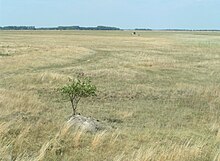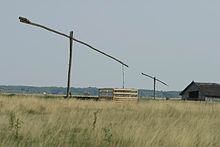Pannonian Steppe




The Pannonian Steppe[1] is a variety of grassland ecosystems[2] found in the Pannonian Basin. It is an exclave of the Great Eurasian Steppe, found in modern-day Austria, Bulgaria, Hungary, Romania, Serbia, Slovakia and easternmost parts of Croatia.[3][4]
Geography
[edit]The Pannonian Steppe is an exclave of the Eurasian Steppe. The climate is continental.
The part of the Pannonian Steppe in Hungary is a grassland biome[5] on the Great Hungarian Plain (Alföld) around the River Tisza in the eastern part of Hungary as well as on the western part of Hungary and in the Austrian Burgenland. The landscape has been widely cultivated and the original landscape is now found only in a few places, for example in Hortobágy National Park.[6]
The characteristic landscape is composed of treeless plains, saline steppes and salt lakes, and includes scattered sand dunes, low, wet forests and freshwater marshes along the floodplains of the ancient rivers.[6] About three hundred species of birds can be found here.[6]
The Čenkovská steppe near Mužla is the only steppe national nature reserve in Slovakia. The protected area declared in 1951 covers a total of 83 hectares.[7][8]

Apart from the Čenkovská forest-steppe, other notable steppe and forest-steppe biomes in Slovakia are located mostly around the Danubian and East Slovak plains and the southern ranges of the Pramatra system. Two of the biomes are Devínska Kobyla and the Slovak Karst (connects to Aggtelek in Hungary).[9][10][11]
The part of the Pannonian steppe in Austria is present in Burgenland mainly around Lake Neusiedl.[12]
See also
[edit]References
[edit]- ^ Természettudományi Múzeum (Hungary), 1969. link: https://books.google.com/books?id=cOrRAAAAMAAJ&q=%22pannonian+steppe%22+pannonian+basin
- ^ "Samen kaufen – große Saatgut Auswahl im Online-Shop | Asklepios Seeds" (PDF).
- ^ The European Commission (DG ENV B2) commissioned the Management of Natura 2000 habitats, 2008. http://ec.europa.eu/environment/nature/natura2000/management/habitats/pdf/6260_Pannonic_sand_steppes.pdf ISBN 978-92-79-08328-0
- ^ n.a. (10 June 2022). "Obavijest o provođenju javne rasprave prijedloga plana upravljanja područjima ekološke mreže stepska staništa kod Bapske, Opatovca i Šarengrada" (in Croatian). Town of Ilok. Retrieved 18 April 2024.
- ^ Ward Chesworth, Encyclopedia of Soil Science, Springer, 2008, p. 66
- ^ a b c Peter Haggett, Encyclopedia of World Geography: Eastern Europe, p. 1781
- ^ Informačný portál rezortu MŽP SR. http://uzemia.enviroportal.sk/main/detail/cislo/22 Slovak Environmental Agency, 2012
- ^ "Čenkovská lesostep - informačná tabuľa | Vizuálna dvojjazyčnosť - Databanka | foruminst.sk". Archived from the original on 2012-08-04. Retrieved 2012-02-23. Foruminstitut 2011
- ^ "Archived copy". Archived from the original on 2012-01-20. Retrieved 2012-03-22.
{{cite web}}: CS1 maint: archived copy as title (link) - ^ "FFS - Abstrakty". Archived from the original on 2007-07-02. Retrieved 2012-03-22.
- ^ "Devínska Kobyla | Watching.sk". Archived from the original on 2012-05-18. Retrieved 2012-03-22.
- ^ "Burgenland - die Sonnenseite Österreichs: Lake Neusiedl World Heritage site". Archived from the original on 2011-08-05. Retrieved 2012-03-09.
External links
[edit]